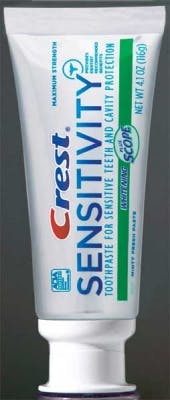Potassium nitrate, sodium fluoride, strontium chloride, and NovaMin technologies for dentin hypersensitivity
By Maria Perno Goldie, RDH, MS
As with any other medical or dental treatment, prevention is the most cost-effective “treatment” option. Regarding dentin hypersensitivity, the initial recommendation by an oral health professional focus on cessation of harmful habits and the twice-daily use of a desensitizing dentifrice. Tray application of potassium nitrate can be an effective intermittent treatment for sensitivity according to limited practice-based evidence. Clinical trials have shown that twice-daily use of desensitizing dentifrices improves hypersensitivity and increases in effectiveness over time.(1) Professionally applied dentin desensitizers and at home products include: oxalate products, calcium phosphate desensitizers; 5% NaF varnish; Glutaraldehyde-HEMA; HEMA + other products, NaF; SnF2; light-cured adhesives; glass-ionomer cements; desensitizing dentifrices; potassium containing products; strontium chloride; and NovaMin containing products. This article will focus on potassium nitrate, sodium fluoride, strontium chloride, and NovaMin technologies.Desensitizing dentifrices and other products containing 5% potassium nitrate (KNO3) lower nerve sensitivity.(2, 3) According to the literature, the most widely available desensitizing toothpaste ingredient is potassium nitrate.(4) The potassium ions are thought to block the synapse between nerve cells, reducing nerve excitation and the associated pain.(5) Another active ingredient that exhibits a similar mechanism is potassium chloride. According to Pat Walters, RDH, MSDH, MSOB other treatments are designed to reduce flow into the dentin tubules by occluding or sclerosing the tubules.(5) Active ingredients include stannous fluoride, strontium chloride hexahydrate, and aluminum, potassium or ferric oxalates and fluorides.
As with any other medical or dental treatment, prevention is the most cost-effective “treatment” option. Regarding dentin hypersensitivity, the initial recommendation by an oral health professional focus on cessation of harmful habits and the twice-daily use of a desensitizing dentifrice. Tray application of potassium nitrate can be an effective intermittent treatment for sensitivity according to limited practice-based evidence. Clinical trials have shown that twice-daily use of desensitizing dentifrices improves hypersensitivity and increases in effectiveness over time.(1) Professionally applied dentin desensitizers and at home products include: oxalate products, calcium phosphate desensitizers; 5% NaF varnish; Glutaraldehyde-HEMA; HEMA + other products, NaF; SnF2; light-cured adhesives; glass-ionomer cements; desensitizing dentifrices; potassium containing products; strontium chloride; and NovaMin containing products. This article will focus on potassium nitrate, sodium fluoride, strontium chloride, and NovaMin technologies.Desensitizing dentifrices and other products containing 5% potassium nitrate (KNO3) lower nerve sensitivity.(2, 3) According to the literature, the most widely available desensitizing toothpaste ingredient is potassium nitrate.(4) The potassium ions are thought to block the synapse between nerve cells, reducing nerve excitation and the associated pain.(5) Another active ingredient that exhibits a similar mechanism is potassium chloride. According to Pat Walters, RDH, MSDH, MSOB other treatments are designed to reduce flow into the dentin tubules by occluding or sclerosing the tubules.(5) Active ingredients include stannous fluoride, strontium chloride hexahydrate, and aluminum, potassium or ferric oxalates and fluorides.
Products with the ADA Seal of Acceptance include: GlaxoSmithKline Consumer Healthcare Sensodyne Fresh Impact Toothpaste; and Procter & Gamble Co. Crest Pro-Health Night Toothpaste; Crest Pro-Health Toothpaste; and Crest Pro-Health Whitening Toothpaste.(6) This list is not exhaustive, as there are several other dentifrices available over-the-counter (OTC) that reduce tooth sensitivity and do not carry the ADA seal. 5% KNO3 can also occlude the dentinal tubules and reduce fluid flow within the tubules.(7)
A Cochrane Review compared the effectiveness of potassium containing toothpastes with control toothpastes in reducing dentin hypersensitivity.(8) Randomized controlled trials (RCTs) in which the effect on dentin hypersensitivity of potassium containing toothpastes was tested against non-potassium containing control toothpastes. Sensitivity was assessed by using thermal, tactile, air blast, and subjective methods. Six studies were included in the meta-analysis which showed the statistically significant effect of potassium nitrate toothpaste on air blast and tactile sensitivity at the 6 to 8 weeks follow up, e.g. the meta-analysis of air blast sensitivity showed a standardized mean difference in sensitivity score of -1.25 (95% CI: -1.65 to -0.851) in favor of treatment. The subjective assessment failed to show a significant effect at the 6- to 8-week assessment. The author’s concluded that the evidence generated by this review was based on a small number of individuals, and the effect varied with the methods applied for assessing the sensitivity. No clear evidence is available for the support of potassium containing toothpastes for dentin hypersensitivity according to the authors.(8)The purpose of a recently published systematic review was to compare oxalate treatment compared with no treatment or placebo with a dentin hypersensitivity outcome.(9) According to the authors, with the possible exception of 3% monohydrogen monopotassium oxalate, available evidence currently does not support the recommendation of dentin hypersensitivity treatment with oxalates.Strontium chloride and strontium acetate have been incorporated in toothpastes for many years and are well documented. While studies show improvement in patients’ perception of pain, the effectiveness of the product at reducing symptoms appears to increase with increased usage.(10) As well, fluoride compounds have been studied for the treatment of dentin hypersensitivity, including sodium fluoride, sodium silico-fluoride, stannous fluoride and sodium monofluorophosphate. Fluorides may mechanically block the tubules. Professionally applied sodium fluoride and oxalates have been administered with equivocal efficacy, and other fluoride varnishes assessed clinically have not shown superiority from the control varnish.(11) The most recent technology in this category is a bioactive glass called NovaMin. NovaMin (NovaMin Technology, Alachua, Fla.) was introduced into the dental market as a desensitizer in December 2004. The objective of one study was to determine the ability of a calcium sodium phosphosilicate (NovaMin) particulate to occlude dentin tubules, and hence decrease hypersensitivity.(12) The conclusion was that NovaMin adheres to an exposed dentin surface and reacts with it to form a mineralized layer. The layer formed is resistant to acid challenges and is mechanically strong. The continuous release of calcium over time is suggested to maintain the protective effects on dentin, and provide continual occlusion of the dentin tubules. Another study showed that a NovaMin dentifrice was more effective at reducing sensitivity compared with a commercial dentifrice and placebo control.(13) A recent study evaluated the effectiveness of 100 percent NovaMin powder with NovaMin-containing toothpaste in reducing dentin hypersensitivity compared with the effectiveness of NovaMin-containing toothpaste only and a desensitizing toothpaste containing potassium nitrate as a control.(14) The use of NovaMin powder and NovaMin-containing toothpaste for hypersensitivity reduction proved more effective than the use of desensitizing toothpaste containing potassium nitrate and fluoride in this study. NovaMin was acquired by GlaxoSmithKline in 2010.(15) It can also be found in prophylaxis paste and toothpaste.(16)
While this article touches the surface of this topic, the literature abounds with articles on treatment of hypersensitivity.References
1. Ajcharanukul O, Kraivaphan P, Wanachantararak S, Vongsavan N, Matthews B. Effects of potassium ions on dentine sensitivity in man. Arch Oral Biol. 2007;52(7):632-639.2. Nagata T, Ishida H, Shinohara H, et al. Clinical evaluation of a potassium nitrate dentifrice for the treatment of dentinal hypersensitivity. J Clin Peridontol 1994;21 (3):217-21. 3. Haywood VB, Caughman WF, Frazier KB, et al. Tray delivery of potassium nitrate fluoride to reduce bleaching sensitivity. Quintessence Int. 2001;32:105-109.4. Canadian Advisory Board on Dentin Hypersensitivity: Consensus-based recommendations for the diagnosis and management of dentin hypersensitivity. J Can Dent Assoc 2003;69(4); 221-6.5. Walters PA. Dentinal Hypersensitivity: A Review. The Journal of Contemporary Dental Practice, Volume 6, No. 2, May 15, 2005. www.dentalcare.com/media/en-US/research_db/pdf/jcdp/waltersspr05.pdf Accessed March 14, 2011. 6. www.ada.org/productsearch.aspx accessed March 14, 2011.7. Knight NN, Tryggve L, Clark SM, et al. Hypersensitive Dentin: Testing of procedures for mechanical and chemical obliteration of dentinal tubuli. J Periodontol 1993;64:366-373.8. Poulsen S, Errboe M, Lescay Mevil Y, and Glenny A-M. Potassium containing toothpastes for dentine hypersensitivity. Cochrane Database of Systematic Reviews 2006, Issue 3. Art. No.: CD001476. DOI: 10.1002/14651858.CD001476.pub2.9. Cunha-Cruz J, Stout JR, Heaton LJ, Wataha JC, for Northwest PRECEDENT. Dentin Hypersensitivity and Oxalates: a Systematic Review. J Dent Res 90(3):304-310, 2011.10. West N X. The dentine hypersensitivity patient – a total management package. International Dental Journal (2007) 57, 411-419.11. Ritter AV, de L Dias W, Miguez P et al. Treating cervical dentin hypersensitivity with fluoride varnish: a randomized clinical study. J Am Dent Assoc 2006 137: 1029.12. Burwell A, Jennings D, Muscle D, Greenspan DC. NovaMin and dentin hypersensitivity--in vitro evidence of efficacy. J Clin Dent. 2010;21(3):66-71.13. Du Min Q, Bian Z, Jiang H, Greenspan DC, Burwell AK, Zhong J, Tai BJ. Clinical evaluation of a dentifrice containing calcium sodium phosphosilicate (NovaMin) for the treatment of dentin hypersensitivity. Am J Dent. 2008 Aug;21(4):210-4.14. Narongdej T, Sakoolnamarka R, and Boonroung T. The Effectiveness of a Calcium Sodium Phosphosilicate Desensitizer in Reducing Cervical Dentin Hypersensitivity: A Pilot Study. J Am Dent Assoc, Vol 141, No 8, 995-999.15. my.gain-net.org/forum/topics/novamin-acquired-by Accessed March 14, 201116. www.prevent.dentsply.com/nusolutions/ToothPaste-Brochure.pdf Accessed March 14, 2011.Additional Reading
Minimal Intervention Dentistry. Woman Dentist Journal. www.dentistryiq.com/index/display/article-display/301967/articles/woman-dentist-journal/volume-5/issue-4/you-and-your-practice/minimal-intervention-dentistry.html. Accessed March 14, 2011.
1. Ajcharanukul O, Kraivaphan P, Wanachantararak S, Vongsavan N, Matthews B. Effects of potassium ions on dentine sensitivity in man. Arch Oral Biol. 2007;52(7):632-639.2. Nagata T, Ishida H, Shinohara H, et al. Clinical evaluation of a potassium nitrate dentifrice for the treatment of dentinal hypersensitivity. J Clin Peridontol 1994;21 (3):217-21. 3. Haywood VB, Caughman WF, Frazier KB, et al. Tray delivery of potassium nitrate fluoride to reduce bleaching sensitivity. Quintessence Int. 2001;32:105-109.4. Canadian Advisory Board on Dentin Hypersensitivity: Consensus-based recommendations for the diagnosis and management of dentin hypersensitivity. J Can Dent Assoc 2003;69(4); 221-6.5. Walters PA. Dentinal Hypersensitivity: A Review. The Journal of Contemporary Dental Practice, Volume 6, No. 2, May 15, 2005. www.dentalcare.com/media/en-US/research_db/pdf/jcdp/waltersspr05.pdf Accessed March 14, 2011. 6. www.ada.org/productsearch.aspx accessed March 14, 2011.7. Knight NN, Tryggve L, Clark SM, et al. Hypersensitive Dentin: Testing of procedures for mechanical and chemical obliteration of dentinal tubuli. J Periodontol 1993;64:366-373.8. Poulsen S, Errboe M, Lescay Mevil Y, and Glenny A-M. Potassium containing toothpastes for dentine hypersensitivity. Cochrane Database of Systematic Reviews 2006, Issue 3. Art. No.: CD001476. DOI: 10.1002/14651858.CD001476.pub2.9. Cunha-Cruz J, Stout JR, Heaton LJ, Wataha JC, for Northwest PRECEDENT. Dentin Hypersensitivity and Oxalates: a Systematic Review. J Dent Res 90(3):304-310, 2011.10. West N X. The dentine hypersensitivity patient – a total management package. International Dental Journal (2007) 57, 411-419.11. Ritter AV, de L Dias W, Miguez P et al. Treating cervical dentin hypersensitivity with fluoride varnish: a randomized clinical study. J Am Dent Assoc 2006 137: 1029.12. Burwell A, Jennings D, Muscle D, Greenspan DC. NovaMin and dentin hypersensitivity--in vitro evidence of efficacy. J Clin Dent. 2010;21(3):66-71.13. Du Min Q, Bian Z, Jiang H, Greenspan DC, Burwell AK, Zhong J, Tai BJ. Clinical evaluation of a dentifrice containing calcium sodium phosphosilicate (NovaMin) for the treatment of dentin hypersensitivity. Am J Dent. 2008 Aug;21(4):210-4.14. Narongdej T, Sakoolnamarka R, and Boonroung T. The Effectiveness of a Calcium Sodium Phosphosilicate Desensitizer in Reducing Cervical Dentin Hypersensitivity: A Pilot Study. J Am Dent Assoc, Vol 141, No 8, 995-999.15. my.gain-net.org/forum/topics/novamin-acquired-by Accessed March 14, 201116. www.prevent.dentsply.com/nusolutions/ToothPaste-Brochure.pdf Accessed March 14, 2011.Additional Reading
Minimal Intervention Dentistry. Woman Dentist Journal. www.dentistryiq.com/index/display/article-display/301967/articles/woman-dentist-journal/volume-5/issue-4/you-and-your-practice/minimal-intervention-dentistry.html. Accessed March 14, 2011.
Maria Perno Goldie, RDH, MS
To read other FOCUS articles written by Maria Perno Goldie, RDH, MS, go to articles.




